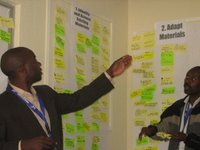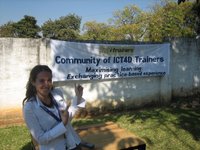The e-collaboration community of practice, a group of people working for development organisations in the Netherlands (which started a
blog on its domain here) is almost one year old and the 'facilitators' decided to ask an external person,
John Smith, to look back and help to design the next steps. I co-facilitate the group of behalf of
IICD with Sibrenne Wagenaar from
PSO. We wanted the exercise to function as an exchange between members of the group rather than having a formal external evalution, so John had about 5 teleconferences with small groups of people, and we had a face-to-face session yesterday. I was a little hesitant to ask people to talk about the group at a meta-level (talking more about the process of group development, rather than about a content topic). In general, I had been hesitant to use the name community of practice for the group too, because in a way even after a full year, it feels we are just at the beginning.
Without posting all the minutes, I think this blog is a good place to share my reflections about this whole exercise.
1. I think the exercise in itself was powerful to strengthen the group, by calling it a community of practice outloud. One person said she now realizes that she is part of this community of practice. Having an outsider name the dilemmas the CoP is facing is also a very good intervention in itself, when it is not named, the group can not work with the dilemmas as a group. I'm thinking that could be stronger function for us, as leaders of this community of practice in future too.
2. It was funny to see how people have different interpretations of the history. My history starts where I joined the process, but there were other interactions before I joined, and I assumed that my co-facilitator Sibrenne was part of the initial stages, but she wasn't either. Though I'm a big advocate of building on what has happened rather than starting new things from scratch, I see how easy it is to ignore processes that are important but which you were not part of.
3. Though the set-up of the exercise did not allow us to look at the value created by the community of practice (a big worry for me), I learned to look at value simply by 'voting with their feet'. The fact that people show up at meetings and that the group is growing is also an indication of value created. How to articulate this value to the organisations is another question though.
4. John mentioned the word 'shoptalk' a lot. As important for learning within a community of practice. Though I have an idea of what this means, I forgot to ask what exactly he means by this, but it did make a lot of sense to the group. We also talked about the important of creating both private and public spaces. This exercise is a nice example of that for myself; though it was good to have the face-to-face meeting, I feel I learned most from the preparatory teleconference where we discussed the evolution of our domain, and the talks afterwards where Sibrenne and I had the chance to ask all our questions about community leadership. Our exchange about 'removing' skype contacts, dealing with overload of contacts and other skype conventions in the bus is a good example of this kind of talk too I think.
5. Co-facilitating this group has been very important. Not only in sharing the burden of 'work' and being there when the other is on holidays or travelling, but also to be less lonely and have someone to share your observations and dilemmas.
Though we have a private, password-protected wiki for reflections, I'm first blogging this. Half a year ago, it would have been the other way around. That means my level of comfort with blogging my own learning process has increased tremendously! (beyond embarassment :))
 handvest van de aarde
handvest van de aarde
















